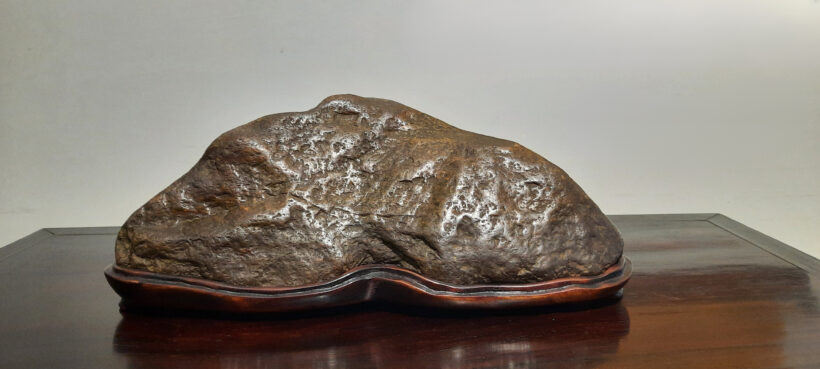“Veiled melancholy under an autumn moon“
–
Member
Mr. Cosimo Pepe
Classification
Landscape Stone – Sansui keijo seki
Distant mountain stone – Toyama ishi
Poetic name
‘Autumn mountain’
Origin
Italy (Toce river)
Measurements (cm)
L 31 – D 17 – H 13
Kakejiku
Tsukihaiga – Moon and calligraphy
古寺の茶釜も踊れ今日の月
“Even the kettles of ancient temples dance under this harvest moon”
Calligrapher and painter name: Mr. Nakamura Fusetsu (1866-1943)
First month of autumn. The best month for observing the moon. The night gradually lengthens, leaving more time to appreciate its brightness, enhanced by the growing chill in the night air that amplifies its beauty. It is here and now: it is the soul of autumn nights. The moon is everywhere, it is intangible and luminous substance: it illuminates the deep and still mountain, but there is no place where the moon does not arrive on an autumn night, erasing the concrete distance from human things. In haiku one sings of its reflection in the humble pot, in the water bucket, in the tea kettle, in the cup of sake, on the river, on the sea. The ancient festival where people gather and pray to the moon, called “お月見 Otsukimi,” falls in September. The origin of the festival was probably rooted in agricultural rituals, linked to the growth of rice and the beginning of the harvest. It was thus a time of gratitude and sharing the joy of an abundant harvest. In Heian times, aristocrats held lavish parties, reciting poetry on boats and enjoying sake. Poised between the warm colors of autumn and the one-color world of winter, we still enjoy the beauty of autumn leaves, shining on the trees in a spectrum of scarlet, amber and gold. At a slight breeze the leaves break off, twirl and dance, fall in a brief scarlet rain: it is a spectacle that moves the hearts of poets and thinkers to ‘autumn blight,’ to melancholy and a growing feeling of loneliness and emptiness. It is late autumn, as we wait and dread winter.
“Velata malinconia sotto una luna d’autunno”
–
Socio
Cosimo Pepe
Classificazione
Pietra Paesaggio- Sansui keijo seki
Montagna distante – Toyama ishi
Nome poetico
‘Montagna d’autunno’
Origine
Italia (Fiume Toce)
Dimensioni (cm)
L 31 – D 17 – H 13
Kakejiku
Tsukihaiga – Luna e calligrafia
古寺の茶釜も踊れ今日の月
“Anche i bollitori degli antichi templi danzano sotto questa luna del raccolto”
Nome del calligrafo e pittore: Nakamura Fusetsu (1866-1943)
Primo mese d’autunno. Il mese migliore per osservare la luna. La notte si allunga a poco a poco, lasciando più tempo per apprezzarne la luminosità, accresciuta dal freddo crescente nell’aria notturna che ne amplifica la bellezza. È qui ed ora: è l’anima delle notti d’autunno. La luna è dovunque, è sostanza intangibile e luminosa: illumina la montagna profonda e immota, ma non vi è luogo dove la luna non arrivi in una notte d’autunno, annullando la distanza concreta dalle umane cose. Negli haiku se ne canta il riflesso: nell’umile pentola, nel secchio dell’acqua, nel bollitore del tè, nella tazza di sakè, sul fiume, sul mare. L’antica festa in cui ci si riunisce e si prega la luna, chiamata “お月見 Otsukimi”, cade in settembre. L’origine della festa era probabilmente radicata nei rituali agricoli, collegata alla crescita del riso e all’inizio del raccolto. Era quindi un momento di gratitudine e di condivisione della gioia di un abbondante raccolto. In epoca Heian, gli aristocratici organizzavano feste sontuose, recitando poesie sulle barche e gustando sakè. In bilico, tra i caldi colori dell’autunno e il mondo di un solo colore dell’inverno, ancora godiamo della bellezza delle foglie autunnali, che brillano sugli alberi in uno spettro di scarlatti, ambra e oro. Ad un leggero soffio di vento le foglie si staccano, volteggiano e ballano, cadono in una breve pioggia scarlatta: è uno spettacolo che muove il cuore dei poeti e dei pensatori alla ‘ruggine autunnale’, verso la malinconia ed un crescente sentimento di solitudine e di vuoto. È il tardo autunno, mentre aspettiamo e temiamo l’inverno.



